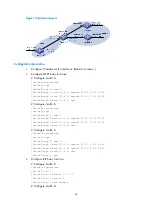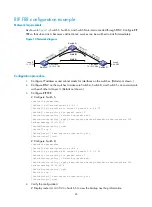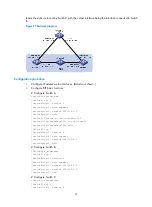
36
•
Bidirectional detection in BFD control packet mode for an indirectly connected neighbor. In this
mode, a BFD session is established only when both ends have routes to send and BFD is enabled
on the receiving interface.
For more information about BFD, see
High Availability Configuration Guide
.
Single-hop echo detection mode
To configure BFD for RIP (single-hop echo detection mode):
Step Command
Remarks
1.
Enter system view.
system-view
N/A
2.
Configure the source IP
address of BFD echo packets.
bfd echo-source-ip
ip-address
By default, no source IP address is
configured for BFD echo packets.
3.
Enter interface view.
interface
interface-type
interface-number
N/A
4.
Enable BFD on the RIP
interface.
rip bfd enable
Disabled by default.
Bidirectional control detection mode
This feature only works for RIP neighbors that are directly connected (one hop away from each other).
To configure BFD for RIP (bidirectional control detection mode):
Step Command
Remarks
1.
Enter system view.
system-view
N/A
2.
Create a RIP process and
enter RIP view.
rip
[
process-id
] [
vpn-instance
vpn-instance-name
]
By default, RIP is disabled.
3.
Specify a RIP neighbor.
peer
ip-address
By default, RIP does not unicast
updates to any peer.
4.
Enter interface view.
interface
interface-type
interface-number
N/A
5.
Enable BFD on the RIP
interface.
rip bfd enable
Disabled by default.
NOTE:
Because the
undo peer
command does not remove the neighbor relationship at once, executing the
command cannot bring down the BFD session at once.
Displaying and maintaining RIP






























